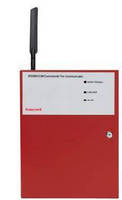Honeywell IP/GSM Fire Alarm Communicator Proves Worthy Investment
Share:

No. Carolina Installer & AHJ Tout IPGSM-DP's Cost-Savings, Increased Reliability
NORTHFORD, Conn - Honeywell (NYSE: HON) announces the deployment of its IPGSM-DP fire alarm communicator at a number of luxury apartment complexes in Wilmington, N.C., saving property managers thousands of dollars each month as they cut traditional phone lines in favor of the new technology.
The IPGSM-DP offers a choice of either IP (Internet Protocol) or GSM (Global System for Mobile Communications) cellular as the main pathway for reporting fire alarm signals to a central monitoring station. In Wilmington, with the approval of the local AHJ (authority having jurisdiction) and state officials, the devices have found a ready market, reports Justin MacDaniel, sales consultant with ASG Security.
"The nice part about this product is it allows the customer to ditch the phone lines," says MacDaniel. "We've always known there was interest from end users - now that we have the technology that matches that interest, it's a win-win."
MacDaniel's first big customer was a luxury apartment complex, consisting of 17 individual buildings, each with an MS-9200UDLS fire alarm system from Fire-Lite Alarms. The fire alarm control panel in each building utilized two telephone lines, a primary and a backup, costing the property manager a total of $90 per month for both lines. Altogether, these phone line expenses totaled $1,530 for all buildings.
The IPGSM-DP tests its connection with the central monitoring station every five minutes as opposed to the once-a-day check-in typically performed when using traditional phone lines.
This increased reliability is one of the major benefits of the system from a life safety point of view, says Capt. Kenneth L. Bogan of the Wilmington Fire Department's Fire and Life Safety Division, the local AHJ.
"We're going from a traditional 24-hour window for the system to do a handshake with the central station to every five minutes," explains Bogan. "That in and of itself adds a greater layer of durability. That's the main pro that I have."
Along with regular supervision of communications pathways, the IPGSM-DP's ability to utilize IP and GSM technology together improves the reliability and speed of communications over single path technology.
Bogan says local alarm contractors first brought the new IPGSM-DP to his attention, and when fire officials learned the technology had received its UL listing and met NFPA-72 requirements, they forwarded the information on to the state's Department of Insurance. The communication technology was approved for use, and has grown in popularity.
"We expect to see them deployed more rapidly due to the fact that for many years commercial properties have tried to find a cost alternative to the two required phone lines for traditional communications," says Bogan. "The number one selling point we're hearing with this is the client can actually earn the money back of what it costs to upgrade, and experience a substantial savings over the many years it's in operation."
MacDaniel says he sold the luxury apartments property manager - who wasn't a previous customer - on the cost savings. With the sale, ASG Security also picked up the property's alarm monitoring business, as well, a decent $10 a month per panel of RMR (Recurring Monthly Revenue).
MacDaniel says his firm has installed Honeywell's IP/GSM communicator at several other apartment complexes in the area, plus a number of local restaurants and other businesses - all eager to cut the cost of dual phone lines.
"It's something the industry has been wanting for a long, long time and now it's out like wildfire," observes MacDaniel. "We can't keep these units on the shelf."
Installation was a snap, explains MacDaniel. The IPGSM-DP is simply a box to mount within three feet or so of the fire alarm control panel, and ties easily into the control panel's existing phone line ports. With a minor amount of programming, the entire installation takes about two hours, MacDaniel estimates.
The IPGSM-DP is UL-Listed to provide full Contact ID data reporting for virtually any brand of fire alarm control panel through Honeywell's AlarmNet network.
A simple configuration setup allows installers to select one of two modes of operation. In mode one, IP is the primary path and GSM is the backup with SMS (Short Message Service) text serving as a secondary backup. In mode two, either IP or GSM cellular can be set as the fire alarm system's single path for reporting. A 256-bit Advanced Encryption Standard is used to secure data traveling through each pathway.
"It's not a major install at all, which helps keep the price down for the end user," says MacDaniel. "As for the customer's ROI, they're going to pay this product off in eight to ten months. And after that time, they're just saving all that money."
The unit is powered by its own plug-in transformer and accommodates a 24-hour battery back-up. For North Carolina, which sits in the middle of Hurricane Alley, power backup is essential, states MacDaniel.
Bogan notes the IP/GSM communications technology is still new for the alarm sector, and he's looking forward to seeing how the devices work.
"If it's a durable technology that's code compliant and it saves the customer money, than everyone wins," exclaims Bogan.
For more information on the features and benefits of the IPGSM-DP, visit www.honeywellpower.com.
Honeywell International (www.honeywell.com) is a Fortune 100 diversified technology and manufacturing leader, serving customers worldwide with aerospace products and services; control technologies for buildings, homes and industry; automotive products; turbochargers; and specialty materials. Based in Morris Township, N.J., Honeywell's shares are traded on the New York, London, and Chicago Stock Exchanges. For more news and information on Honeywell, please visit www.honeywellnow.com.
Media Contact: Beth Welch, 203-484-6202 or beth.welch@honeywell.com




